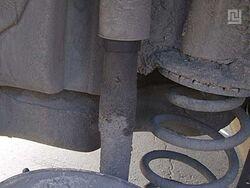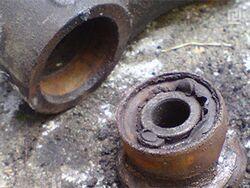Introduction
Based on the requests of our customers, most of which live in cold regions of Russia, we analyzed the cases of failure of suspension parts. One of the main reasons for the destruction of spare parts is operation in severe frosts. As you know, already at -20 ° C, most rubbers begin to lose their elasticity. This has an extremely negative effect on various cuffs, gasket rings and other products whose task is to ensure tightness. In the car suspension, especially CV joints and hydraulic shock absorbers, are most affected by low temperatures.
CV joint dust boot
The specificity of the CV joint device is such that it requires plentiful and constant lubrication, does not tolerate dirt. Tightness is ensured by rubber protective covers (CV joint dust boots). The CV boots of the hinges are in the form of a corrugation so that each time the anther is compressed, the grease smeared along the walls returns to the hinge. In case of leakage, any lubricant (most often, on a molybdenum or lithium base) is rapidly oxidized (or squeezed out through the boot), which leads to wear of the entire assembly.
Visual illustration of the effect of low temperatures on the CV dust boot
Hydraulics, shock absorbers
Hydraulic shock absorbers running on oil can break down when operating in cold weather.
Under the influence of frost, not only does the viscosity of the oil change, but the rubber bushings of the shock absorber lose their elasticity. Because of this, oil may leak from the shock absorber and the shock absorber breaks.
In addition to changing the viscosity of the oil under the influence of frost, as a result of freezing, the rubber bushings of the shock absorber lose their elasticity, which leads to leakage of the working fluid of the shock absorber and its breakdown.
Silent blocks
Do not think that only valve-free products (cv boots, bushings) suffer from severe frosts – this also applies to silent blocks, in which the most common problem is the separation of rubber / polyurethane from the metal. To solve the above problems and due to the lack of such an offer on the market, we are working to increase the stability of suspension parts to severe frosts. The work is carried out in several directions: increasing the resistance of the material to low temperatures and making changes to the design of parts. For example, we began to produce pressed and prefabricated silent blocks – due to the initial lack of connection between the material and the internal metal sleeve, separation from the internal reinforcement is impossible, and from the external it is practically excluded due to a significant reduction in load.
Frost resistant polyurethane
Our experts have developed a unique formula for frost-resistant polyurethane, which remains operational at temperatures up to -50 ° C. This fundamentally distinguishes our products not only from rubber analogues, but also from polyurethane products of foreign manufacturers, which do not set themselves the goal of adding such a property as frost resistance.
Polyurethane spare parts from other manufacturers
Polyurethane suspension parts of many manufacturers are of high quality, reliability and durability, surpassing rubber counterparts in many respects.
But they are usually not designed to operate at temperatures below -15 ° C. This is especially true for Australian manufacturers.
Polyurethane cv boot does not lose its properties in any weather
Conclusion
The combination of frost resistance with an advanced design makes our products unique. Product is tested at low temperatures is regularly conducted in the laboratory. In addition, in the winter of 2011-2012, tests were conducted in Yakutia, and our products withstood the “frost torture”.










Сайлентблок, в традиционном понимании сущности, подразумевает перемещение наружной обоймы относительно внутренней только за счёт упругого СКРУЧИВАНИЯ эластичного элемента. Если внутренняя втулка прокручивается в полиуретане – это уже не сайлентблок, а подшипник скольжения со всеми вытекающими отсюда проблемами износа.
Не совсем верно, внутренняя втулка запрессована с преднатягом, до критических углов данный сайлентблок работает как обыкновенный.
https://blog.polyurethan.ru/2013/04/15/silent-block/
-43°с.Втулка рессоры PU54/M71/оранжевый окаменела, благо машина зимой не ездит иначе бы втулка рассыпалась или уши рессор оторвало))) не заметил при какой температуре она задубела. Теперь только весной это узнаю.
Олег, при минус 43 оранжевая втулка будет твёрже, чем при плюсовой температуре, но можно не беспокоиться, она не рассыплется и уши рессор не оторвёт. Полиуретановая втулка при начале движения быстрее приходит в рабочее состояние, нежели резиновая. Это тоже преимущество полиуретана.
Здравствуйте а зелёный матерьял сайлентблоков до какой температуры.?
Доброго дня! Зеленый цвет полиуретана в наших сайлентблоках говорит о твердости материала – 80 ед. по шкале ШорА (жесткость полиуретана). Сохраняет свои рабочие свойства до минус 40 град, на морозе при ударных нагрузках не крошится, остается упругим, в отличие от резины.